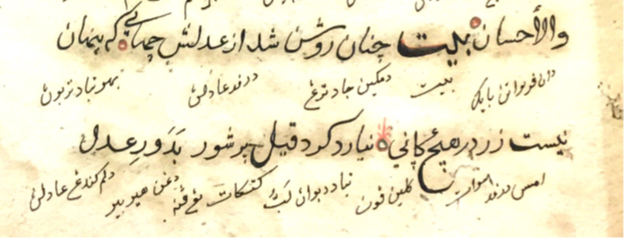(Day 3. Iran and the Malay-Indonesian World)
On the #Jawi and #Persian Languages, common terms and literature with photos https://abs.twimg.com/emoji/v2/... draggable="false" alt="😉" title="Winking face" aria-label="Emoji: Winking face">:
https://abs.twimg.com/emoji/v2/... draggable="false" alt="😉" title="Winking face" aria-label="Emoji: Winking face">:
1/Arabic was mainly introduced as the written language of Islam (mainly its scriptures) by local and foreign scholars of Islam in the Archipelago.
On the #Jawi and #Persian Languages, common terms and literature with photos
1/Arabic was mainly introduced as the written language of Islam (mainly its scriptures) by local and foreign scholars of Islam in the Archipelago.
2/However, some manuscripts show that Malays used to learn the Arabic language through Persian texts; those which were about Arabic language sciences. As such, they translated these Persian materials.
3/The style of translations suggests: to what extent Malay scribes and translators were familiar with the Persian language. They were really good, believe me! ;) see the following pictures (see: 5&6):
4/These pictures from a very old Persian-Malay manuscript on Arabic , display the way Persian poems as well as Persian texts about the grammar of the Arabic were translated into Jawi (Jawi is the classical Malay language/script including Arabo-Persian letters).
5/Here the couplet, by which the manuscript begins, says:
چنان روشن شد از عدلش جهانی*که پنهان نیست زر درهیچ کانی
and I romanized/transliterated the Malay interlinear translation as:
"Demikian jadi terang daripada adil-nya*bahwa tiada terbunyi emas daripada suatu galian pun"
چنان روشن شد از عدلش جهانی*که پنهان نیست زر درهیچ کانی
and I romanized/transliterated the Malay interlinear translation as:
"Demikian jadi terang daripada adil-nya*bahwa tiada terbunyi emas daripada suatu galian pun"
6/ or here about a grammatical issue:
و فعل متعدی آن فعلی است که از فاعل بمفعولٌ بِهِ تجاوَز...
and I transliterate the Malay translation as follows:
"Bermula fe‘el muta‘addi itu ia itu fe‘el yang daripada fa‘el-nya kapada maf‘ul-nya"
و فعل متعدی آن فعلی است که از فاعل بمفعولٌ بِهِ تجاوَز...
and I transliterate the Malay translation as follows:
"Bermula fe‘el muta‘addi itu ia itu fe‘el yang daripada fa‘el-nya kapada maf‘ul-nya"
7/In fact, after the Srivijaya/Sriwijaya dynasty which had a significant influence on the Malay-Indonesian world for centuries, Arabic as the main language of Islam entered the Malay-Indonesian world. Thereafter, a local form of the language of Islam known as Jawi using
8/Arabo-Persian scripts, was applied by Malaysians, Acehnese and North Sumatra inhabitants until a few decades ago. There are only a few Jawi letters which cannot be found in Arabic and Persian.
9/For example ڠ can be read as "ng"
or ڤ read as "p"
and ݢ read as "g"
and ۏ read as "v"
and ڽ read as "ny/nya"
or ڤ read as "p"
and ݢ read as "g"
and ۏ read as "v"
and ڽ read as "ny/nya"
10/Interestingly, there are hundreds of Persian words in Malay-Indonesian.
For example, Anggur (انگور) = Grape
Anjir (انجیر) = Fig;
Bandar (بندر)= Port;
Biadab (بی ادب) =Rude;
Kalamkari (قلمکاری) = Painting on fabric using a qalam or pen;
Dawat (دوت/دوات)= Ink
For example, Anggur (انگور) = Grape
Anjir (انجیر) = Fig;
Bandar (بندر)= Port;
Biadab (بی ادب) =Rude;
Kalamkari (قلمکاری) = Painting on fabric using a qalam or pen;
Dawat (دوت/دوات)= Ink
11/
Badam (بادام)=Almond, etc.
However, there are several terms which are rarely used (i.e., written form) by Malays these days: e.g.,
Sardi (سردی) = "Cold in the head"
Koba (کوبه)= a kind of Tamburo/Drum
Badam (بادام)=Almond, etc.
However, there are several terms which are rarely used (i.e., written form) by Malays these days: e.g.,
Sardi (سردی) = "Cold in the head"
Koba (کوبه)= a kind of Tamburo/Drum
12/Moreover, traces of Persian can be seen in the following Malay literary sources: religious works (kitab), folk stories (hikayat), court literature (adab), poems (syair). I will also add one more category, “occultism and magic” which may be related to the genre of Kitab. ~Majid

 Read on Twitter
Read on Twitter



